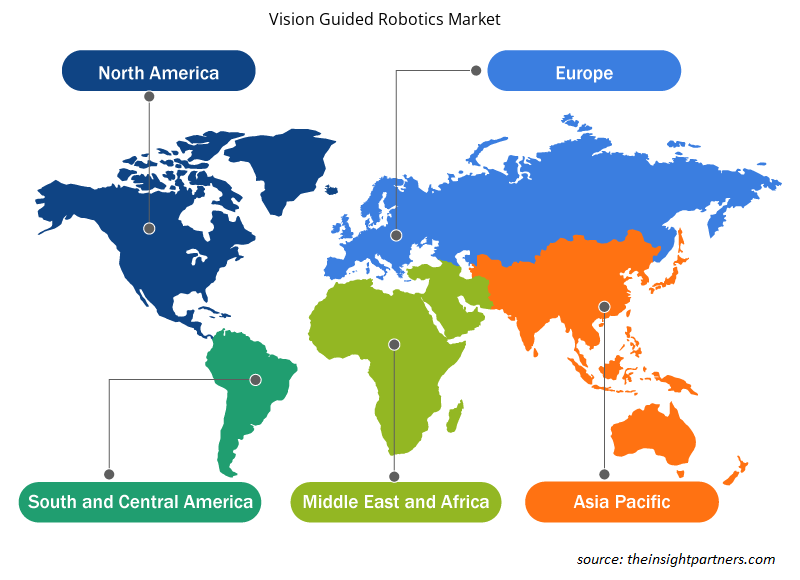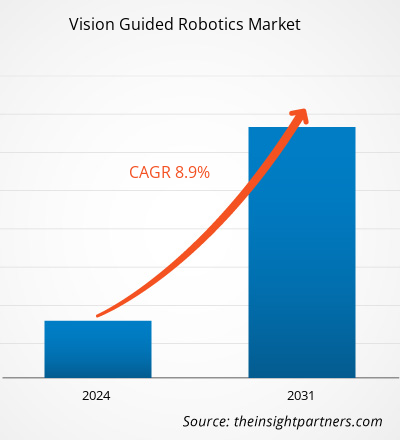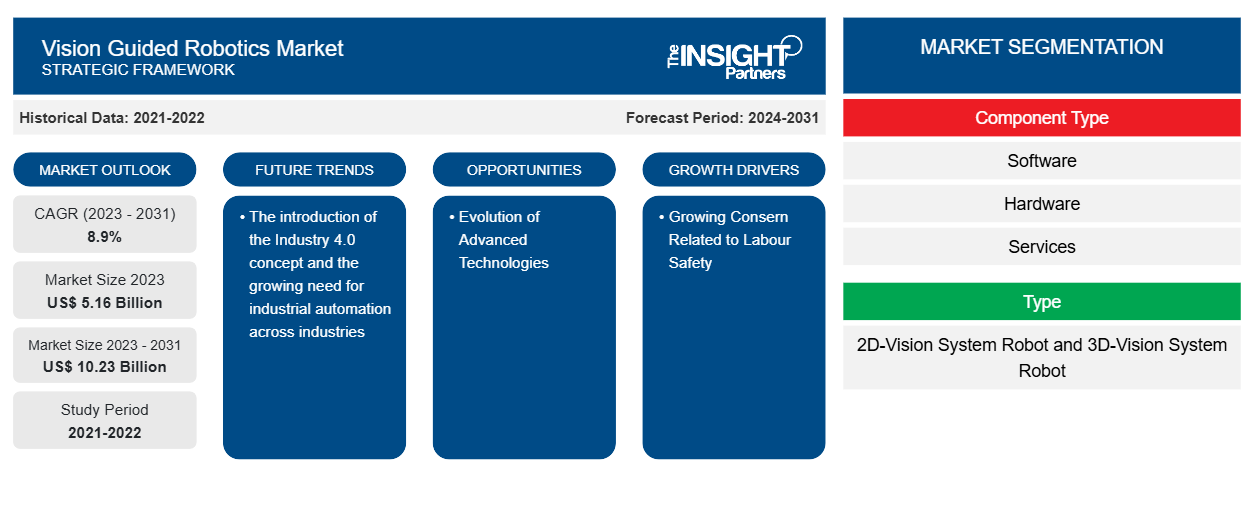Se prevé que el tamaño del mercado de robótica guiada por visión alcance los 10.230 millones de dólares en 2031, frente a los 5.160 millones de dólares en 2023. Se espera que el mercado registre una CAGR del 8,9 % entre 2023 y 2031. Es probable que la introducción del concepto de Industria 4.0 y la creciente necesidad de automatización industrial en todas las industrias sigan siendo una tendencia clave en el mercado de robótica guiada por visión.
Análisis del mercado de la robótica guiada por visión
El mercado de la robótica guiada por visión está creciendo a un ritmo rápido debido a la creciente preocupación relacionada con la seguridad laboral, la mayor demanda de inspección y control de calidad entre las industrias y la creciente adopción de la robótica guiada por visión en las pymes. El mercado se está expandiendo de manera constante, impulsado por el creciente uso de robots colaborativos en entornos de fabricación colaborativa. Además, la evolución de tecnologías avanzadas y los desarrollos en tecnología de visión artificial están brindando oportunidades lucrativas para el crecimiento del mercado.
Descripción general del mercado de robótica guiada por visión
La robótica guiada por visión es un sistema robótico que emplea algoritmos de visión artificial y cámaras para permitir que los robots realicen tareas que requieren percepción e interpretación visual. La idea principal detrás de la robótica guiada por visión es brindar a los robots la capacidad de ver y comprender su entorno, lo que les permite navegar, interactuar con cosas y realizar tareas de manera más precisa y eficiente. Los robots guiados por visión a menudo utilizan cámaras de alta resolución, procesamiento de imágenes moderno y algoritmos de aprendizaje automático para evaluar datos visuales y emitir juicios en función de ellos. La robótica guiada por visión se usa comúnmente para actividades de selección y colocación, ensamblaje e inspección, empaquetado y control de calidad. La creciente adopción de la robótica guiada por visión en numerosas industrias, como la automotriz, aeroespacial y de defensa, alimentos y bebidas, eléctrica y electrónica, atención médica y farmacéutica, procesamiento de metales y otras, está impulsando el mercado.
Personalice este informe según sus necesidades
Obtendrá personalización en cualquier informe, sin cargo, incluidas partes de este informe o análisis a nivel de país, paquete de datos de Excel, así como también grandes ofertas y descuentos para empresas emergentes y universidades.
-
Obtenga las principales tendencias clave del mercado de este informe.Esta muestra GRATUITA incluirá análisis de datos, desde tendencias del mercado hasta estimaciones y pronósticos.
Factores impulsores y oportunidades del mercado de la robótica guiada por visión
La creciente preocupación por la seguridad laboral impulsa el mercado
A medida que los requisitos internacionales de seguridad laboral se vuelven más estrictos, las industrias de todo el mundo están cambiando su preferencia hacia la adopción de robots para reemplazar a los trabajadores humanos en áreas peligrosas. Los robots pueden realizar tareas que son dañinas e inseguras para los humanos, lo que aumenta su demanda en áreas peligrosas, incluida la operación en terrenos difíciles y la gestión de sustancias peligrosas. Las industrias pueden reducir los riesgos, y la cantidad de accidentes laborales mediante el uso de robots en ciertos entornos riesgosos está impulsando el mercado de la robótica guiada por visión durante el período de pronóstico.
Evolución de las tecnologías avanzadas: una oportunidad en el mercado de la robótica guiada por visión
La introducción de nuevas tecnologías ha dado lugar al desarrollo de robótica más eficaz y eficiente en el mercado. Estos robots tecnológicamente avanzados pueden realizar tareas con mayor precisión y exactitud, lo que se traduce en menores costes. Por tanto, se crean oportunidades de crecimiento del mercado durante el período de previsión.
Los avances tecnológicos han hecho que los sistemas robóticos sean más compactos y modulares, lo que da como resultado robots de mayor calidad y más versátiles. El creciente uso de robots aumentados y modulares está generando importantes oportunidades de crecimiento para el mercado en el futuro cercano.
Análisis de segmentación del informe de mercado de robótica guiada por visión
Los segmentos clave que contribuyeron a la derivación del análisis del mercado de robótica guiada por visión son el tipo de componente, el tipo y la vertical de la industria.
- Según el tipo de componente, el mercado de robótica guiada por visión se divide en software, hardware y servicios. El segmento de hardware tuvo una mayor participación de mercado en 2023.
- Según el tipo, el mercado se segmenta en robots con sistema de visión 2D y robots con sistema de visión 3D. El segmento de robots con sistema de visión 3D tuvo una mayor participación de mercado en 2023.
- En términos de sectores verticales, el mercado se clasifica en automoción, aeroespacial y defensa, alimentos y bebidas, atención médica y farmacéutica, electricidad y electrónica, procesamiento de metales y otros. El segmento automotor tuvo una mayor participación de mercado en 2023.
Análisis de la cuota de mercado de la robótica guiada por visión por geografía
El alcance geográfico del informe de mercado de robótica guiada por visión se divide principalmente en cinco regiones: América del Norte, Asia Pacífico, Europa, Medio Oriente y África, y América del Sur / América del Sur y Central.
En términos de ingresos, Asia Pacífico representó la mayor participación en el mercado de robótica guiada por visión, debido a las tecnologías emergentes y al alto volumen de capacidades de fabricación. Además, se espera que la creciente implementación del concepto de Industria 4.0 y el aumento de la inversión de las empresas para establecer instalaciones de fabricación impulsen la demanda durante el período de proyección.
Noticias y desarrollos recientes del mercado de robótica guiada por visión
El mercado de la robótica guiada por visión se evalúa mediante la recopilación de datos cualitativos y cuantitativos posteriores a la investigación primaria y secundaria, que incluye publicaciones corporativas importantes, datos de asociaciones y bases de datos. A continuación, se incluye una lista de los avances en el mercado de la robótica guiada por visión y las estrategias:
- En marzo de 2023, Smart Vision Lights copatrocinará el seminario web de Quality Magazine, que analiza la evolución reciente de la robótica guiada por visión y ayuda a orientar a las empresas que buscan nuevas soluciones de automatización. El seminario web estará dirigido a todos los interesados en la tecnología de robótica guiada por visión, incluidos los departamentos de gestión de empresas, calidad y plantas, ingeniería y operaciones, independientemente del mercado. (Fuente: Smart Vision Lights, comunicado de prensa, 2023)
Informe de mercado sobre robótica guiada por visión: cobertura y resultados
El informe “Tamaño y pronóstico del mercado de robótica guiada por visión (2023-2031)” proporciona un análisis detallado del mercado que cubre las siguientes áreas:
- Tamaño del mercado y pronóstico a nivel global, regional y nacional para todos los segmentos clave del mercado cubiertos bajo el alcance
- Dinámica del mercado, como impulsores, restricciones y oportunidades clave
- Principales tendencias futuras
- Análisis detallado de las cinco fuerzas de Porter y PEST y FODA
- Análisis del mercado global y regional que cubre las tendencias clave del mercado, los principales actores, las regulaciones y los desarrollos recientes del mercado.
- Análisis del panorama de la industria y de la competencia que abarca la concentración del mercado, el análisis de mapas de calor, los actores destacados y los desarrollos recientes
- Perfiles detallados de empresas
Alcance del informe
Perspectivas regionales del mercado de robótica guiada por visión
Los analistas de Insight Partners explicaron en detalle las tendencias y los factores regionales que influyen en el mercado de robótica guiada por visión durante el período de pronóstico. Esta sección también analiza los segmentos y la geografía del mercado de robótica guiada por visión en América del Norte, Europa, Asia Pacífico, Oriente Medio y África, y América del Sur y Central.

- Obtenga datos regionales específicos para el mercado de robótica guiada por visión
Alcance del informe de mercado de robótica guiada por visión
| Atributo del informe | Detalles |
|---|---|
| Tamaño del mercado en 2023 | 5.160 millones de dólares estadounidenses |
| Tamaño del mercado en 2031 | US$ 10,23 mil millones |
| CAGR global (2023 - 2031) | 8,9% |
| Datos históricos | 2021-2022 |
| Período de pronóstico | 2024-2031 |
| Segmentos cubiertos |
Por tipo de componente
|
| Regiones y países cubiertos |
América del norte
|
| Líderes del mercado y perfiles de empresas clave |
|
Densidad de actores del mercado de robótica guiada por visión: comprensión de su impacto en la dinámica empresarial
El mercado de la robótica guiada por visión está creciendo rápidamente, impulsado por la creciente demanda de los usuarios finales debido a factores como la evolución de las preferencias de los consumidores, los avances tecnológicos y una mayor conciencia de los beneficios del producto. A medida que aumenta la demanda, las empresas amplían sus ofertas, innovan para satisfacer las necesidades de los consumidores y aprovechan las tendencias emergentes, lo que impulsa aún más el crecimiento del mercado.
La densidad de actores del mercado se refiere a la distribución de las empresas o firmas que operan dentro de un mercado o industria en particular. Indica cuántos competidores (actores del mercado) están presentes en un espacio de mercado determinado en relación con su tamaño o valor total de mercado.
Las principales empresas que operan en el mercado de robótica guiada por visión son:
- Compañía: ABB Ltd.
- Basilea AG
- Cognex
- Corporación Denso
- Corporación Fanuc
- Visión de la ISRA
Descargo de responsabilidad : Las empresas enumeradas anteriormente no están clasificadas en ningún orden particular.

- Obtenga una descripción general de los principales actores clave del mercado de robótica guiada por visión
- Análisis histórico (2 años), año base, pronóstico (7 años) con CAGR
- Análisis PEST y FODA
- Tamaño del mercado, valor/volumen: global, regional y nacional
- Industria y panorama competitivo
- Conjunto de datos de Excel
Informes recientes
Testimonios
Razón para comprar
- Toma de decisiones informada
- Comprensión de la dinámica del mercado
- Análisis competitivo
- Información sobre clientes
- Pronósticos del mercado
- Mitigación de riesgos
- Planificación estratégica
- Justificación de la inversión
- Identificación de mercados emergentes
- Mejora de las estrategias de marketing
- Impulso de la eficiencia operativa
- Alineación con las tendencias regulatorias























 Obtenga una muestra gratuita para - Mercado de robótica guiada por visión
Obtenga una muestra gratuita para - Mercado de robótica guiada por visión